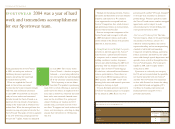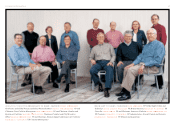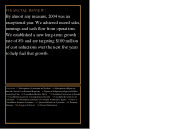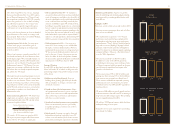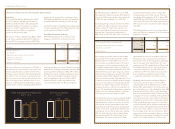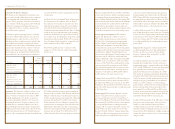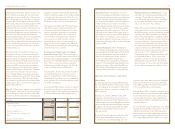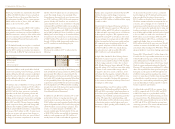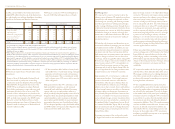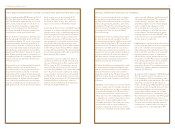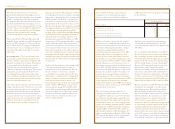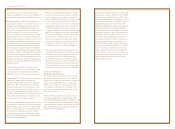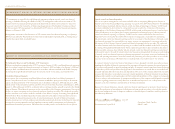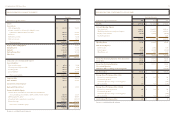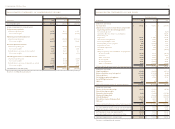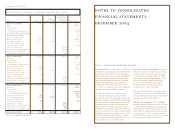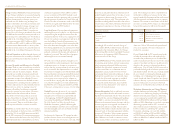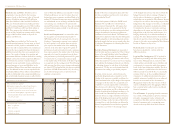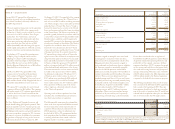North Face 2004 Annual Report Download - page 33
Download and view the complete annual report
Please find page 33 of the 2004 North Face annual report below. You can navigate through the pages in the report by either clicking on the pages listed below, or by using the keyword search tool below to find specific information within the annual report.
61vf corporation 2004 Annual Report
In 2002, cash provided by discontinued operations
totaled $69.9 million from the sale of the Jantzen busi-
ness and related assets and from liquidation of working
capital from the Jantzen and knitwear businesses.
Following is a summary of VF’s fixed obligations at
the end of 2004 that will require the use of funds:
Payments Due or Forecasted by Period
In millions Total 2005 2006 2007 2008 2009 Thereafter
Long-term debt* $1,622 $ 464 $ 69 $ 69 $ 36 $ 35 $ 949
Operating leases 415 98 84 66 53 39 75
Minimum royalty payments 66 14 17 16 14 5 -
Inventory obligations** 817 682 15 15 15 15 75
Other obligations*** 885 221 111 91 88 87 287
Total $ 3,805 $ 1,479 $ 296 $ 257 $ 206 $ 181 $ 1,386
*Long-term debt service obligations include both principal and related interest.
** Inventory purchase obligations represent commitments for raw material, sewing labor and finished goods in the ordinary course of business
that are payable upon satisfactory receipt of the inventory by VF, plus a commitment to purchase $15.0 million per year through 2013 of
finished goods from one supplier.
***Other obligations represent other commitments for the expenditure of funds, many of which do not meet the criteria for recognition as a
liability for financial statement purposes. These commitments include forecasted amounts related to (1) contracts not involving the purchase
of inventories, such as advertising and the noncancelable portion of service or maintenance agreements, (2) capital expenditures for approved
projects and (3) components of Other Liabilities, as presented and classified as noncurrent liabilities in VF’s Consolidated Balance Sheet,
that will require the use of cash. Projected cash requirements for components of Other Liabilities include (1) portions of those liabilities recorded
in Current Liabilities, (1) discretionary funding contributions to our pension plan trust of $55 million per year through 2009 based on
information provided by our independent actuary and management’s current intent and (3) payments of deferred compensation and other
employee-related benefits based on forecasted activity and prior experience.
We have other financial commitments at the end of
2004 that may require the use of funds under certain
circumstances:
•Shares of Series B Redeemable Preferred Stock
have been issued to participants as matching
contributions under the Employee Stock Ownership
Plan (“ESOP”). If requested by the trustee of the
ESOP, VF has an obligation to redeem Preferred
Stock held in participant accounts and to pay each
participant the value of his or her account. The
amounts of these redemptions vary based on the
conversion value of the Preferred Stock. In 2004 and
2003, no funds were required as the ESOP trustee
elected to convert the Preferred Stock of with-
drawing participants into shares of Common Stock.
Payments made for redemption of Preferred Stock
were $5.8 million in 2002.
•VF has entered into $80.5 million of surety bonds
and standby letters of credit representing contingent
guarantees of performance under self-insurance
and other programs. These commitments would
only be drawn upon if VF were to fail to meet its
claims obligations.
Management believes that VF’s cash balances and
funds provided by operations, as well as unused
committed bank credit lines, additional borrowing
capacity and access to equity markets, taken as a
whole, provide (1) adequate liquidity to meet all of its
obligations when due, (2) adequate liquidity to fund
capital expenditures and to maintain our dividend
payout policy and (3) flexibility to meet investment
opportunities that may arise. Specifically, we believe
VF has adequate liquidity to repay the $100.0 million
and $300.0 million of long-term debt obligations due
in June and October 2005, respectively.
Risk Management
VF is exposed to a variety of market risks in the
ordinary course of business. We regularly assess these
potential risks and manage our exposures to these
risks through our operating and financing activities
and, when appropriate, by utilizing natural hedges
and by creating offsetting positions through the use
of derivative financial instruments. Derivative finan-
cial instruments are contracts in which the payments
are linked to changes in currency exchange rates,
interest rates or other financial measures. We do not
use derivative financial instruments for trading or
speculative purposes.
We limit the risk of interest rate fluctuations on net
income and cash flows by managing our mix of fixed
and variable interest rate debt. In addition, we may
also use derivative financial instruments to minimize
our interest rate risk. Since our long-term debt has
fixed interest rates, our primary interest rate exposure
relates to changes in interest rates on short-term
borrowings, which averaged $96 million during 2004.
However, any change in interest rates would also affect
interest income earned on VF’s cash equivalents on
deposit. Based on average amounts of short-term
borrowings and of cash on deposit during 2004, the
effect of a hypothetical 1.0% change in interest rates
on reported net income would not be material.
Approximately 23% of our business is conducted
in international markets. Our foreign businesses
operate in functional currencies other than the
United States dollar (except in Turkey, where we
use the United States dollar because of the high
inflation rate in that country). Assets and liabilities
in these foreign businesses are subject to fluctuations
in foreign currency exchange rates. Investments in
these primarily European and Latin American busi-
nesses are considered to be long-term investments,
and accordingly, foreign currency translation effects
on those net assets are included in a component of
Accumulated Other Comprehensive Income (Loss)
in Common Stockholders’ Equity. We do not hedge
these net investments and do not hedge the transla-
tion of foreign currency operating results into the
United States dollar.
A growing percentage of the total product needs
to support our businesses are manufactured in our
plants in foreign countries or by independent foreign
contractors. We monitor net foreign currency market
exposures and may in the ordinary course of business
enter into foreign currency forward exchange
contracts to hedge specific foreign currency transac-
tions or anticipated cash flows. Use of these financial
instruments allows us to reduce VF’s overall exposure
to exchange rate movements, since gains and losses
on these contracts will offset losses and gains on the
transactions being hedged. Our practice is to hedge
a portion of our net foreign currency cash flows
(relating to cross-border inventory purchases and
production costs, product sales and intercompany
royalty payments anticipated during the following
12 months) by buying or selling United States dollar
contracts against various currencies.
If there were a hypothetical adverse change in foreign
currency exchange rates of 10% relative to the United
States dollar, the expected effect on the fair value
of the hedging contracts outstanding at the end of
2004 would be approximately $23 million. Based on
changes in the timing and amount of foreign currency
exchange rate movements, actual gains and losses
could differ.
VF is exposed to market risks for the pricing of cotton
and other fibers, which indirectly affects fabric prices.
We manage our fabric prices by ordering denim and
other fabrics several months in advance, but we have
not historically managed commodity price exposures
by using derivative instruments.
VF has nonqualified deferred compensation plans
in which liabilities accrued for the plans’ participants
are based on market values of investment funds that
are selected by the participants. The risk of changes
in the market values of the participants’ underlying
investment selections is hedged by VF’s investments
in a portfolio of securities that substantially mirrors
the investment selections underlying the deferred
compensation liabilities. These VF-owned investment
securities are held in irrevocable trusts. Increases and
decreases in deferred compensation liabilities are
substantially offset by corresponding increases and
decreases in the market value of VF’s investments,
resulting in a negligible net exposure to our operating
results and financial position.


